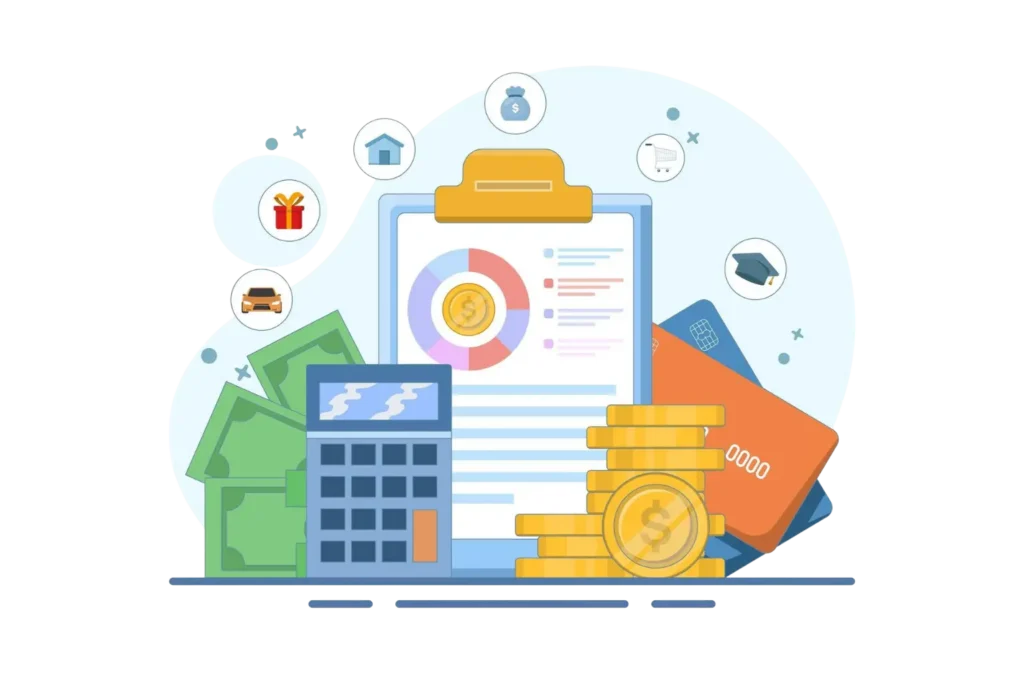
No matter the size or industry of your business, having a reliable expense management solution is essential.
✨
Quick Read
Summary generated by AI, reviewed for accuracy.
At the time of writing, we reviewed ten top expense management tools built to make financial tracking simpler for businesses of every size. Our selection was guided by insights from reputable review sources like G2, focusing on tools that balance reliability, functionality, and flexibility. The ideal choice for your organization will depend on your specific financial workflows
The best expense tracking software can transform how your company handles spending simplifying workflows, cutting down on manual effort, and offering greater visibility into financial activities.
With numerous options available today, choosing the ideal expense management tool comes down to identifying the features and capabilities that best suit your organization’s specific requirements.
In this article, we’ll explore some of the top expense management software solutions currently available in the market.
Importance of Expense Management Tools
Effective financial oversight begins with how an organization records, monitors, and manages its spending. Here is why it is important for your business.
- Central Role in Financial Organization
Expense management tools hold importance as they bring structure to how a company handles financial data.
Without such a system, expenses may be scattered across different sources, making it difficult to maintain order in financial records.
They serve as the foundation for maintaining clarity and consistency in all financial dealings.
- Foundation for Accountability
Having a dedicated expense management app establishes a clear process for recording and approving expenditures.
This framework helps define responsibility at every level of the organization, forming the basis for transparent financial management.
It also reinforces a sense of ownership among employees when handling company funds.
- Essential for Long-Term Planning
Accurate expense records maintained through these tools form the base for effective financial planning.
Organizations depend on this data to understand spending trends and develop strategies that support sustainable growth.
By maintaining consistent financial insights, it helps businesses prepare for future challenges and allocate resources wisely.
- Key to Audit Readiness
Maintaining an organized system for managing expenses is crucial when preparing for internal or external audits.
The importance lies in its ability to keep financial documentation traceable and consistent with regulatory standards.
Such readiness safeguards the company’s credibility during review processes. It also minimizes the risk of discrepancies, making audits smoother and more transparent.
- Integral to Business Continuity
Expense management tools contribute to the stability of an organization’s financial operations.
Their presence reduces the risk of disorganization and supports uninterrupted financial tracking, which is vital for day-to-day business functioning.
Over time, they become a core component that upholds operational consistency. By maintaining steady financial oversight, these systems help organizations stay resilient during periods of change or uncertainty.
Key Features to Look in Expense Management Tools
Choosing the right expense management tool can greatly impact how effectively your organization manages its financial operations. These tools offer a range of powerful capabilities here are some of the most important features to consider.
1. Automated Expenses Management
The contemporary finance business revolves around automation. A study by McKinsey & Company reveals that 98% of CFOs indicate that their finance departments have made investments in some type of digitization or automation programs.
A system that is automated to manage expenses makes the overall workflow involving the capturing of expenses and the generation of reports easier and less repetitive because of manual work.
It enables finance departments to pay more attention to the strategic tasks such as cost management and forecasting rather than to the regular data input.
2. Expense Reconciliation
Proper expense reconciliation is very important in ensuring transparency on the financial side.
An effective expense management tool will automatically align the expenses and transactions and corporate card information and assist the finance teams to check all the details in a short time.
It reduces the differences and offers a transparent audit trail to ensure improved financial accuracy and accountability.
3. Receipt Scanning
Choose a system with the features to scan receipts with the help of OCR ( Optical Character Recognition).
All the employees need to do is upload or take a snapshot of their receipts and the system automatically reads and extracts important information about the receipts like date, amount, and category.
This functionality removes the tediousness of entering data manually and accelerates the submissions and approval processes.
4. Connection with Existing Systems.
An effective expense management tool must integrate easily with your current accounting, payroll and ERP systems.
Integration enables the real-time synchronization of expense information among departments enhancing collaboration and financial visibility.
This is to ensure that there is consistency between expense reporting, budgeting and general financial records.
Recommended Reading: Expense Reporting with QuickBooks Integration
5. Reimbursement
On time reimbursements are important in employee satisfaction. Find solutions that are able to handle reimbursements straight through linked payrolls or payment gateways.
Automated monitoring ensures that employees and finance teams know the status of reimbursement, which fosters transparency and trust.
Options such as automatic approval of low-value claims can also be used to expedite the reimbursement process without jeopardizing compliance.
6. Security
Security of financial data should be one of the priorities. The report by Association of Certified Fraud Examiners report, 2024, states that 13% of fraud schemes are associated with reimbursement of expenses.
An effective tool has several layers of protection which include role-based access, data encryption and audit logs.
It aids in the early identification of irregular expenses trends and prevents sensitive information to be accessed by unauthorized persons.
7. Approval Process
A financial workflow is enhanced by an effective expense approval process. Multi-level approval path expense tools enable managers to view and approve claims in real-time, either at desktop or mobile.
Approval rules that can be configured also assist an organization in ensuring that it complies with the organization policies.
A good expense management tool, which offer an automated notification and reminders, and ensure that approvers do not miss the pending requests.
8. Reporting & Analytics
Controlling business spending requires the use of data-driven insights. High-level reporting and analytics allow finding out the trends of spending, high costs, and compliance gaps.
Decision-makers can easily analyse department, project, or category expenses using visual dashboards, which can be used to develop more effective budget strategies.
Predictive analytics also have the ability to predict patterns of expenses in the future, providing finance teams a proactive strategy to cost control.
10 Top Expense Management Tools for Businesses
Choosing the right expense management tool can transform how your company tracks, reports, and controls spending across teams and departments. Here are some best tools to consider.
| Product | Integrations | Free Trial |
| Expense Tracker 365 | SharePoint, Outlook, MS Teams Power Automate, Power BI and QuickBooks | 14 days |
Navan (formerly TripActions) | NetSuite, QuickBooks, American Express and Xero | Request Demo |
| Zoho Expense | Lyft, HSBC and Zoho Books | 14 days |
| Brex | NetSuite, QuickBooks, Workday and Slack | 30 days |
| Rippling | Salesforce, Jira, HubSpot and QuickBooks | 14 days |
| Volopay | Xero, QuickBooks and NetSuite | Yes / Contact sales |
Bill | Sage, FreshBooks and NetSuite | Contact sales |
| Concur Expense | Omnify Expense, Topia and travel accounting systems | 15 days |
| Expensify | Gusto, Certinia, Wells Fargo and Lyft | 30 days |
Pleo | Oracle NetSuite, QuickBooks and Xero | Connect Sales |
1. Expense Tracker 365
Expense Tracker 365 is a new expense management system that is designed within the Microsoft 365 and is customized to any business, regardless of its size. It introduces receipt scanning, categorisation, and financial reporting to well-known Microsoft apps. The configuration is fast, and it can be heavily integrated with current finance systems.
Key Features
- Artificial intelligence-based receipt scanning and OCR reading.
- Corporate card management
- Quick expense submission mobile app
- Automation
- Per diem
- Authenticate using secure Microsoft 365
- Group based approval workflows
- Dedicated Account Manager
- Multi-currency and category customisation
- Multi-factor authentication
- Dashboards of expenses and insights
Ratings
G2: 4.8
Hear From Our Delighted Clients – G2 Platform
“Expense Tracker 365 is a great app with excellent support. The advanced features make it a complete tool & has really improved our expense tracking and reporting workflow”
Best Known for: The ideal choice for Microsoft 365 users who want to track expenses within the same ecosystem, offering secure workflows and an easy-to-use interface.
Building an Workflow in Microsoft with Expense Tracker 365
- Open Expense Tracker 365 from your Microsoft dashboard and select “New Expense List” using the built-in Expense Manager template.
- Use the default columns to record category, amount, requester, status, and other key expense details.
- Add an Approval Date column to monitor timelines and maintain accountability.
- Include a Reimbursement Due Date column to trigger reminders for on-time payments.
- Attach invoices directly by adding an Invoice (File Upload) column for easy record-keeping.
- Create a Vendor Info column to store payee details and contact information.
- Add a Department column to assign expenses to specific business units.
- Build Custom Views to quickly review expenses pending approval, high-value reimbursements, or vendor-based spending.
2. Navan (formerly TripActions)
Navan is an integrated travel and expense management tool that integrates bookings, corporate cards, and expense reporting. It provides real-time analysis of spending to finance teams and a convenient mobile application to employees. It is designed to integrate travel bookings and expense submissions into a single system, which is designed to support organisations with high business travel volumes.
Key Features
- In-trip expense capturing mobile app.
- Real-time spend dashboards
- Combined travel reservation and costs features.
- Card issuance and spend control in corporations.
- Duplicate and automated fraud detection.
- ERP export and accounting.
- AI-powered spend insights
- Global currency support
Ratings
G2: 4.7
Capterra: 4.6
Best Known for: Providing one platform that deals with business travel and expenses having a powerful mobile experience.
3. Zoho Expense
Zoho Expense is a powerful expense management tool that fits well in small and mid-sized companies. It automates the receipt capture, categorisation and approvals and is easily integrated with Zoho Books and other accounting software. It has an intuitive design that helps both the administrators and employees to have an easy workflow.
Key Features
- Receipt Management
- Expense Management
- Mileage Tracking
- Per Diem
- Petty Cash Management
- Expense Reports
- Approvals
- Policies
- Rules
- Budgets
- Audit & Compliance
Reimbursement
Ratings
G2: 4.5
Capterra: 4.6
Best Known for: This is a scalable, low-cost model that is compatible with the Zoho ecosystem. It’s designed to grow with your business while keeping expense management simple and organized.
4. Brex
Brex is a hybrid of corporate credit cards and enhanced expense management in modern businesses. It gives the finance departments visibility of their spending and also gives an employee friendly interface that is mobile friendly. Brex is designed to suit startups and businesses seeking to manage corporate card and expense.
Key Features
- Ease of Creating Expense Reports
- Bank / Credit Card Integration
- Smart Categorization
- Receipt Capture
- Business Tool Integration
- Automated Reminders
- Granular reporting and analytics dashboards
- Custom workflow developer APIs
Ratings
G2: 4.8
Capterra: 4.5
Best Known for: A single platform that combines corporate cards and expense tracking for fast-growing companies. It simplifies spending management and gives teams better control over company finances.
5. Rippling
Rippling integrates HR, IT and finance functions into one platform which incorporates expense management. Its cost module is closely connected to payroll and HR systems, which connects expense reimbursements to employee information. It is aimed at companies that desire to have people and expenditure under a single location.
Key Features
- Expenses submission and approvals of employees
- Reconciliation of cards and transactions
- Role-based approval processes
- Reimbursement linkage to expense to payroll
- Departmental spend-wise categorisation
- International financial compatibility
- General ledger and data analytics export
Ratings
G2: 4.8
Capterra: 4.9
Best Known for: An integrated solution that brings together HR, IT, and finance with built-in expense management. It helps businesses manage people, processes, and payments from one unified platform.
6. Volopay
Volopay is an expense management tool that integrates employee expenses, vendor payments, and corporate cards. It is created to suit the expanding businesses that require complete visibility and control of capital expenditure. The platform makes it easy to transact and approve multi-currency transactions in a single location.
Key Features
- Expense analytics dashboard
- Corporate physical card
- Corporate virtual cards
- Automated workflow
- Multi-level approval
- Expense reimbursement
- Vendor payouts
- Inter-country and multi-currency payments
Product Ratings
G2: 4.3
Capterra: 4.5
Best Known for: Manages employee and vendor expenses through a single all-in-one spend platform. It helps businesses gain visibility, set budgets, and track every transaction in one place.
7. Bill (Bill.com)
Bill is a financial automation system which simplifies bill payments, approvals, and expense management. It assists companies to ease the vendor management, invoice payments and reimbursements. It is centralised on payables and expenses tracking, and is ideal in small and mid-sized firms.
Key Features
- Approval of invoices and expenses
- Co-ordinated supplier management
- ACH and card payment support
- Invoice related expense tracking
- Departmental spend reports
- Role-based user permissions
- Transactions with full audit trail
Ratings
G2: 4.5
Capterra: 4.7
Best Known: Finance-driven organizations can simplify accounts payable and expense processing with greater accuracy and speed. This approach improves cash flow visibility and strengthens financial control across departments.
8. Concur Expense (SAP Concur)
Concur Expense is a business level platform that provides sophisticated travel and expense management. It incorporates travel bookings, receipt capture and approvals to control the multifaceted corporate spending. It is designed to suit big organisations with international activities and regulatory requirements.
Key Features
- Corporate Card Sync
- Policy Compliance Enforcement
- AI-Powered Insights
- Multi-Currency Support
- Localized Tax Compliance
- Expense Analytics and Reporting
- Detailed Digital Records
- Centralized Documentation for Easy Access
- Built-in audit controls
Ratings
G2: 4
Capterra: 4.3
Best Known for: Huge companies handling international travel and costs in a single, compliant, scalable system.
9. Expensify
Expensify is a company specializing in fast and easy management of expenses for employees and finance teams. It automates receipt scanning, approval workflows, reimbursements, and aging reports, reducing the need for manual spreadsheets. With its mobile-friendly app and powerful integrations, Expensify is a great fit for businesses of all sizes.
Key Features
- Corporate card import
- Global reimbursements
- Receipt scanning
- Expense reports
- Virtual cards
- Spend management
- Travel reimbursement
- Mobile and web interfaces
Ratings
G2: 4.5
Capterra: 4.4
Best Known for: Expense tracking and reimbursements for small and mid-sized businesses are simple and easy to manage. The platform helps teams record, approve, and analyze expenses without added complexity.
10. Pleo
Pleo is an innovative expense and smart-card solution that makes spending in the company easier. It offers teams prepaid cards, receipt tracking, and automated categorisation all in a user-friendly interface. Developed to be flexible, Pleo assists companies in striking a balance between autonomy and financial control of the employees.
Key Features
- Automated expense reports
- Vendor cards
- Accounting system integrations
- Approval workflows
- Corporate Cards
- Mileage Tracker
- Reimbursements
- Accounting
- Advanced card controls
Ratings
G2: 4.7
Capterra: 4.8
Benefits of Using Expense Management Tools
There are numerous benefits to using an expense management tool, and here are some key advantages that can make a real difference to your organization’s financial efficiency.
1. Employee Reimbursement
The reimbursement process is fast and clear with the help of expense management tools.
The details are automatically read by the system, and the claim is sent to be approved. Employees will also be able to monitor the progress of their requests and do not have to make calls to the HR or finance.
This facilitates a better experience and enhances the satisfaction of employees because of the timely payment.
2. Expense Policy Enforcement
The digital expense management tools make it significantly easier to set and follow travel expense policies. Pre-established regulations on spending limits, vendors, travel expenses or entertainment expenses can be set by the businesses.
The system alerts an employee immediately when he/she attempts to post something that does not conform to the rules.
This will prevent unnecessary expenditure and ensure all people are operating within the same guidelines.
3. Enhanced Fraud Prevention
Management tools minimise these risks of expense fraud by maintaining an electronic database of all the transactions with receipts, time and approver information.
Automated checks indicate suspicious activity and assist finance teams to investigate fast.
This will render expense data more reliable and will assist organizations guard their money against misuse.
4. Simplified Reporting
In a Forrester expense survey, more than 55% of decision-makers reported that they have difficulties with good decisions because of missing or incomplete expense information.
This is solved by expense management tools which store all the details in a single location including receipts, approvals and reimbursements.
The platform has the ability to generate instant reports on how money is being spent on departments, projects or teams.
5. Increased Compliance
It can be difficult to keep up with tax regulations, company policies, and audit standards when the expenses are recorded manually.
Expense management tools digitally archive all transactions and automatically document who gave approval to what and when. This enables the data to be easily retrieved to perform an audit or financial review.
Regular record keeping also prevents fines, enhances precision in submitting tax returns and ensures that businesses are prepared to face any form of regulatory audit.
6. Time and Cost Savings
The process of manual expense tracking can take hours of data entry, receipt verification, and approvals.
These tasks can be done in minutes with the help of automation by employees and finance teams. Automatic generation of reports and quicker reimbursements are made.
The decreased paperwork and manual labor reduces the administrative expenses and provides the teams with more time to concentrate on the useful business activities rather than search after the receipts.
7. Global Expense Management
Newsroom Wise found that almost 50% of SMBs that were surveyed indicated that the complexity of international payments is a hindrance to international expansion.
Expense management tool assists in eliminating this obstacle by assisting in various currencies, tax regulations, and international reimbursement plans.
This simplifies the global expense management and assists emerging businesses to grow without having to encounter payment related difficulties.
8. Budget Management in Advance
Expense management tools provide real-time access to the company expenditure enabling managers to get a clear view of the amount of budget they have utilized and the remaining amount.
In case one department is overspending, the managers can be informed in time before the budget is exhausted.
Expense data also over time also illustrates trends like which teams or vendors are the most expensive and this can assist leaders in making wiser financial choices.
5 Factors to Consider Before Selecting Expense Management Tools
We have explored the various tools and its benefits. But selecting the right expense management tool is more than just a financial decision. Here are five best practices to follow.
1. Scalability & Customization
As your organization grows, your expense management tool needs evolve too. A scalable and customizable tool ensures that you don’t have to switch systems as your operations expand.
- Evaluate if the tool supports multi-location or global operations.
- Check whether approval workflows, categories, and dashboards can be tailored to your processes.
- Ensure pricing plans and features can scale as your organization grows.
2. Return on Investment (ROI)
Every software purchase should deliver measurable returns and expense management tools are no exception. The right tool can significantly reduce manual work, prevent policy violations, and improve financial accuracy, all of which contribute to tangible ROI.
- Compare the tool’s cost against potential savings in time and resources.
- Assess how automation reduced manual effort and boosts productivity.
- Track performance indicators such as faster reimbursements and reduced expense errors.
3. Integration Capabilities
Integration is key to creating a connected financial ecosystem. Your expense tool should sync effortlessly with accounting software, HR systems, and ERP platforms to ensure data accuracy and eliminate duplicate entries.
- Confirm compatibility with existing accounting system
- Ensure the tool allows easy data import and export for smooth reconciliation.
- Test integrations during the trial phase to identify potential data sync issues.
4. Security & Compliance
With sensitive financial and employee data at stake, robust security and compliance features are critical. The right expense management tool should adhere to global data protection standards and provide complete control over user access and permissions.
- Verify encryption standards and compliance certifications like ISO or SOC 2.
- Check if the platform supports audit trails and user-level access controls.
- Regularly review vendor policies to stay aligned with updated regulations.
5. AI & Automation
Artificial intelligence and automation are transforming how businesses handle expenses. An AI powered expense management only simplifies repetitive tasks like receipt scanning but also identifies spending anomalies and predicts future expenses.
- Leverage AI for auto-categorization and anomaly detection in expenses.
- Automate approval workflows to speed up reimbursement cycles.
- Use predictive analytics to anticipate spending trends and manage budgets effectively.
Make the Most of Your Expense Management Tool
In every business, managing expenses is one of the most crucial yet challenging tasks. Many organizations still struggle to find the right balance between accuracy, efficiency, and simplicity. An effective tool can turn this challenge into an opportunity to gain better financial visibility and control.
If you’re looking for a user-friendly system that streamlines workflows through automation, try our 14-day free trial of Expense Tracker 365 and experience the difference for yourself.
Join Our Creative Community
Frequently Asked Questions
Does Expense Tracker 365 support mobile submission of receipts on the go?
Yes, employees can capture receipts instantly and upload them through mobile, web, or email, ensuring quick and seamless expense submission from anywhere.
Will we get real-time visibility into spending across teams or projects in Expense Tracker 365?
Yes, interactive dashboards and detailed reports offer real-time insights into expenses across teams, projects, categories, and time periods, helping you monitor spending effectively.
Does Expense Tracker 365 support corporate cards?
Yes, you can easily link company cards, apply spend limits, reconcile transactions automatically, and simplify the entire reimbursement process.
What is T&E software?
T&E software, short for Travel and Expense software, is a digital solution that helps businesses manage, track, and control employee travel and expense activities in one place.
Is Expense Tracker 365 built on a cloud platform?
Yes, Expense Tracker 365 is powered by Microsoft Azure Cloud, providing enterprise-grade security, reliability, and scalability. It allows users to access the platform seamlessly via web or mobile, enabling efficient expense management from anywhere.





_JiluXJRGNl.svg)



















